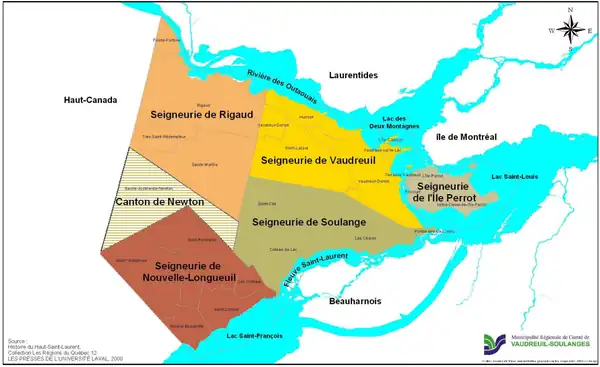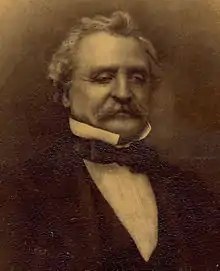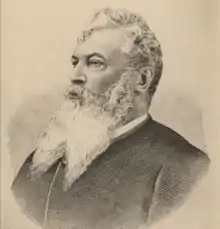| Defunct pre-Confederation electoral district | |
|---|---|
| Legislature | Legislative Assembly of the Province of Canada |
| District created | 1841 |
| District abolished | 1867 |
| First contested | 1841 |
| Last contested | 1863 |
Vaudreuil was an electoral district of the Legislative Assembly of the Parliament of the Province of Canada, in Canada East, west of Montreal. It was created in 1841, based on the previous electoral district of the same name for the Legislative Assembly of Lower Canada.
Vaudreuil was represented by one member in the Legislative Assembly. It was abolished in 1867, upon the creation of Canada and the province of Quebec.
Boundaries
Vaudreuil electoral district was located west of Montreal, between the Saint Lawrence River to the south and the Ottawa River to the north, bordering on Canada West (now in Vaudreuil-Soulanges Regional County Municipality).
The Union Act, 1840 merged the two provinces of Upper Canada and Lower Canada into the Province of Canada, with a single Parliament. The separate parliaments of Lower Canada and Upper Canada were abolished.[1] The Union Act provided that the pre-existing electoral boundaries of Lower Canada and Upper Canada would continue to be used in the new Parliament, unless altered by the Union Act itself.[2]
The Lower Canada electoral district of Vaudreuil was not altered by the Act. It was therefore continued with the same boundaries in the new Parliament. Those boundaries had been set by a statute of Lower Canada in 1829:
Map of Vaudreuil
The seigniories which composed Vaudreuil electoral district were as follows:

Members of the Legislative Assembly (1841–1867)
Vaudreuil was a single-member constituency.[2]
The following were the members of the Legislative Assembly for Vaudreuil. The party affiliations are based on the biographies of individual members given by the National Assembly of Quebec, as well as votes in the Legislative Assembly. "Party" was a fluid concept, especially during the early years of the Province of Canada.[4][5][6]
| Parliament | Member | Years in Office | Party | |||
|---|---|---|---|---|---|---|
| 1st Parliament 1841–1844 |
John Simpson | 1841–1844 | Unionist; "British" Tory | |||
| 2nd Parliament 1844–1847 |
Jacques-Philippe Lantier | 1844–1847 | French-Canadian Group | |||
| 3rd Parliament 1848–1851 |
Jean-Baptiste Mongenais | 1848–1857 | French-Canadian Group | |||
| 4th Parliament 1851–1854 |
Ministerialist | |||||
| 5th Parliament 1854–1857 |
Bleu | |||||
| 6th Parliament 1858–1861 |
Robert Unwin Harwood[lower-alpha 1] |  |
1858–1860 | Conservative | ||
| Jean-Baptiste Mongenais[lower-alpha 2] | 1860–1861 (By-election) |
Bleu | ||||
| 7th Parliament 1861–1863 |
Jean-Baptiste Mongenais | 1861–1863 | Bleu | |||
| 8th Parliament 1863–1867 |
Antoine Chartier de Lotbinière Harwood |  |
1863–1867 | Confederation; Conservative | ||
Notes
- ↑ Resigned seat, October 3, 1860, to stand for election to the Legislative Council: J.O. Côté, Political Appointments and Elections in the Province of Canada from 1841 to 1865, 2nd ed. (Ottawa: G.E. Desbarats, 1865), p. 114.
- ↑ Elected in by-election, November 26, 1860: Côté, Political Appointments and Elections, 2nd ed., p. 114.
Abolition
The district was abolished on July 1, 1867, when the British North America Act, 1867 came into force, creating Canada and splitting the Province of Canada into Quebec and Ontario.[7] It was succeeded by electoral districts of the same name in the House of Commons of Canada[8] and the Legislative Assembly of Quebec.[9]
See also
References
- ↑ Union Act, 1840, 3 & 4 Vict. (UK), c. 35, s. 2.
- 1 2 Union Act, 1840, s. 18.
- ↑ An Act to make a new and more convenient subdivision of the Province into Counties, for the purpose of effecting a more equal Representation thereof in the Assembly than heretofore, SLC 1829 (9 Geo. IV), c. 73, s. 1, para. 26.
- ↑ J.O. Côté, Political Appointments and Elections in the Province of Canada, 1841 to 1860 (Quebec: St. Michel and Darveau, 1860), pp. 43–58.
- ↑ Québec Dictionary of Parliamentary Biography, from 1764 to the present.
- ↑ Paul G. Cornell, Alignment of Political Groups in Canada, 1841–67 (Toronto: University of Toronto Press, 1962; reprinted in paperback 2015), pp. 93–111.
- ↑ British North America Act, 1867 (now the Constitution Act, 1867), s. 6.
- ↑ Constitution Act, 1867, s. 40, para. 2.
- ↑ Constitution Act, 1867, s. 80.
![]() This article incorporates text from this source, which is in the public domain: Statutes of Lower Canada, 13th Provincial Parliament, 2nd Session (1829), c. 74.
This article incorporates text from this source, which is in the public domain: Statutes of Lower Canada, 13th Provincial Parliament, 2nd Session (1829), c. 74.